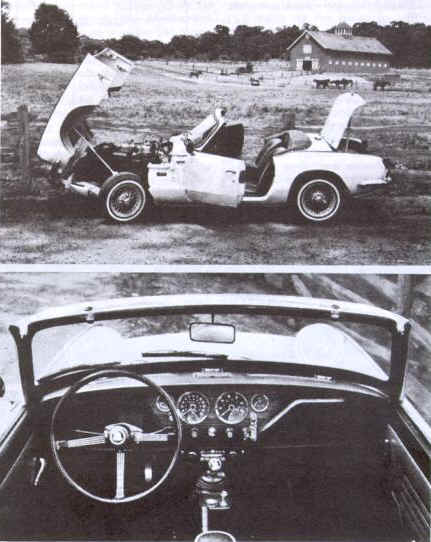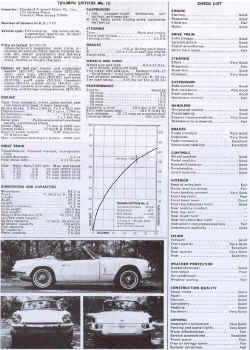Keep your foot in it, and the Spitfire just keeps gathering speed-it'll cruise at 70 mph without strain.
gasoline, a quarter-tank (10
quarts) allows you about three days to find a gas station.
The
thrifty will love the Triumph's ability to wring miles out of a gallon
even when driven fast. But only an oriental mystic in the bed-of-nails
tradition will enjoy the things the car does to one's legs. Assume the
position behind the wheel and you will immediately notice a couple of
things. First, it will come to you that having one's left leg stretched
out into nothingness, and the right leg crooked well back, is
uncomfortable. This is mostly un- avoidable, as the clutch, brake and
accelerator pedals are quite closely situated, while the toe-board is up
there by the wheel-well. Moving the entire control- pedal group forward,
and adding a rest, or "dead-pedal" for one's left foot would
make the driver much more comfortable. The second revelation comes after
you have been driving for a time. Then, you become aware that your right
shin, which falls naturally against a structural member bracing the cowl,
is beginning to ache.
Our
Spitfire had all of the posh extras, including a good AM-FM radio. Often,
a good radio is wasted in a sports car, be- cause there is so much noise
you can't hear it anyway. It is worth having in the Spit- fire; the car is
fairly quiet by overall small- car standards, and really exceptional for a
small sports car. Engine noise is very muted, and the raucous blat from
the exhaust we once considered a sine qua non for Triumphs has been
subdued to a nice, mellow hummmm. Even wind noise is largely
absent. The top doesn't flap or drum, and you can run along at speed with
both windows cranked down without get- ting a lot of buffeting.
Such
noise as is there all seems to come from the drive train, and in the form
of road-rumble. There is a bit of transmission whine, and a kind of
muffled grumbling from the prop shaft and final drive. Not the worrisome
type noise; just an aware- ness that things are whirling and churning
earnestly.
Handling
and general road behavior is a mixture of good and bad. On the good side,
we must say that the car feels well balanced. Swing-axle rear suspensions,
like that on the Spitfire, tend to produce over- steer. Nose-heavy weight
distribution tends to produce understeer. The Spitfire carries 57.7% of
its 1680 lbs. in the front, and that forward weight bias seems to exactly
cancel whatever oversteering tendencies the rear suspension might lend.
On the beneficial side, too, is the car's low center of gravity. We don't know what
this
would be in inches, but it is obviously very low-because that is how the
car is built. Triumph uses a backbone frame under the Spitfire, and the
frame structure dodges around to allow people and major components close
proximity with the road surface. Even with the narrow track (49 inches in
front, 48 inches at the rear) the Spitfire stands securely planted on the
road.
All sports cars have quick steering-it is an article of faith-and the Spitfire's steering is as quick as most. But it doesn't really feel that way. In fact, it feels a trifle heavy and lifeless. We decided after some reflection on the matter that it feels as though there is not enough caster at the front wheels and too much friction in the
steering. So the car feels dull
and unresponsive at low speed; becoming dull and twitchy when you get
motoring along rapidly. The steering friction may have been peculiar to
our particular car, or might disappear with more breaking-in. Caster is
built in at the factory and any sweeping corrections would have to be made
there.
One of the reasons for buying a Mk. III anything is to be one-up on those who have the Mk. 11 version of whatever it is. Thus, nothing is more irritating than having a Mk. III that looks exactly like a Mk. 11 or maybe only a Mk. 11-and-a-half. You can relax. The Spitfire Mk. III has external,

